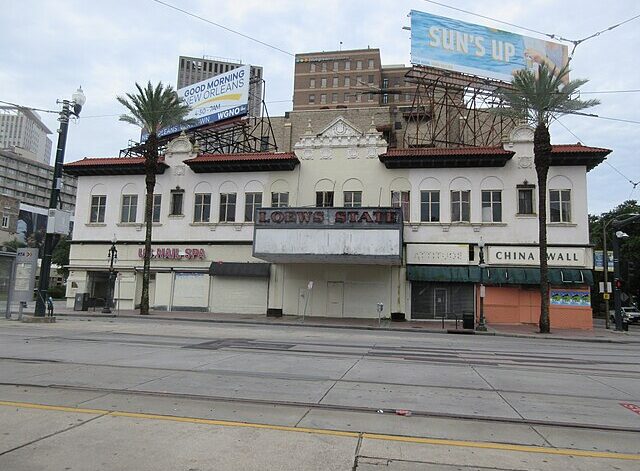Distracted by opulent mansions in the Garden District and heavily-dressed fried shrimp po-boys, it took me a few months after moving here in 2003 to realize New Orleans was a neglected city. When I worked up the courage to journey beyond self-delineated safety zones, I began to notice the crumbling buildings, graffiti tags and trailing vines competing to wholly conceal facades and curtain broken windows.
Born and raised in the San Francisco Bay Area, a metropolis bursting at the seams with almost no space left unsung, the abandoned structures in New Orleans were simultaneously gloomy and alluring. Questions flooded my brain; Who built this? What did it mean to the city? Why has it been forsaken? Will it ever be cared for again or will it one day be demolished and replaced?
This is my personal exploration of the abandoned and neglected public structures in New Orleans. This is Tumbledown NOLA.
***
Casey and Brandon were the first people I met after moving here over 20 years ago. Though I was a decade older, that didn’t stop the young couple from whole-heartedly welcoming me into their city. With them I experienced my first crawfish boil, late nights spent couch-bound burning endless blunts in the Hi-Ho’s backroom, and early mornings inhaling greasy spoon breakfasts at the Trolley Stop Cafe on St. Charles Avenue.
While I never was brave enough to accept their invitations, Casey and Brandon often regaled me with stories of the raves they attended at State Palace, a crumbling theater building on Canal Street. Though I’d experienced more than my share of beach raves in California, I couldn’t work up the nerve to party ‘till dawn inside a dilapidated theater. Regardless, their stories, and the building itself, still fascinated me.
Opened nearly a century ago in 1926 with its distinctive Spanish Colonial Revival-inspired façade, The Palace was one of many Loew’s Theaters popping up across the country. On opening night in the spring of that year,The Devil’s Circus starring Norma Shearer was the first film to show at The Palace Theater. Marcus Loew himself, appeared on stage that night with silent film stars Buster Keaton and Lew Cody among others, heralding the new Canal Street venue.
Like many public spaces in the Southern United States at that time, the theater was segregated with a separate ticket booth, entrance and seating area in the balcony for its non-white patrons. It changed to a “whites-only” establishment in 1950, though that eventually changed with the Civil Rights Act in 1964 and gradual deconstruction of Jim Crow laws.
The structure was designed by prominent, Scottish-born architect Thomas W. Lamb, well known for his lavish designs, creating plush “movie palaces” for Fox, Keith Albee (later known as RKO) and, of course, Loews theater chains. The cinema he designed for the corner of Canal and Basin streets boasted the capacity to seat 3,335 people and a 3/13 Robert Morton pipe organ. Unfortunately, the organ fell into disuse after the early 30s with the advent of “talkies” and was later destroyed in a flood.
In the mid-70s, the theater was expanded to become a triplex, partitioned to feature two screens on the main floor and the balcony offering the third. Less than a decade later, the theater was sold to Wilson P. Abraham, a developer who planned to raze the building and build condominiums in its place, but that plan never came to fruition.
Rene Brunet, Jr., beloved local owner of the Prytania Theater (among others) with the cinema in his blood, leased the Palace from Abraham in the late 1980s. In an attempt to bring the cinema back to its former glory, Brunet removed the partitions and opened up the balcony, uncovered the marble walls in the lobby and returned the single large screen to the main floor. He changed name to State Palace Theater and along with showing classic films and television shows, the space became a live music venue, featuring performances by Ministry, Stone Temple Pilots, Phish and Green Day.
In the mid-90s, arguably the building’s most fascinating era, the theater became the premier venue for the city’s raves, gaining national notoriety for its epic, wildly-themed electronic concerts featuring DJs from across the country. Late, late night concerts were organized by local event-producer James D. Estopinal Jr. aka Disco Donnie, star of the 2004 documentary film Rise: The Story of Rave Outlaw Disco Donnie. State Palace raves in their heyday included performances by drum and bass phenom Danny The Wildchild, hip-hop DJ Q-Bert, Baltimore-based Charles Feelgood, the Bassbin Twins from California, trance music DJs Christopher Lawrence and Michael Myers, and local one-man band Quintron.
My friend Casey Sander, an avid fan of electronica and the New Orleans rave scene, distinctly recalls a State Palace concert featuring Rabbit in the Moon, an American group whose style drew from house, trance and breakbeat, and the first to mix theatrical stage performances into their acts. “I remember [State Palace] would get so packed that the walls would sweat. We wore those big-ass JNCO pants and they would have 6 inches of nasty raver funk on the bottom.” She also emphasized a sense of inclusivity. “No one cared at all about sexual orientation or race, everyone was there participating together.”
During the midnight raves, the theater was split into three separate “rooms of sound.” The main floor housed featured acts, the upstairs “jungle room” (named for an EDM genre called jungle bass) and a side space dubbed the chill room. “Sometimes you could go out on the roof,” recalled Sander. “I watched the sun rise from that roof multiple times.” According to her, the posters advertising various raves over the years also became highly collectible, similar to the psychedelic, 60s era flyers for shows at the Fillmore in San Francisco.
Misfortune befell the State Palace rave scene when in 1998, a 17-year-old girl attending one of the concerts suffered convulsions from drug complications, went into a coma and died several days later. Estopinal and the State Palace Theater became part of a nationwide federal investigation into raves and the drug culture they were said to promote. Though undercover agents were sold ecstasy and LSD by attendees during several performances, when they raided the State Palace, a thorough investigation found no evidence of drugs, only cases of water bottles, pacifiers and glowsticks.
After Hurricane Katrina and the levee failures in 2005, the State Palace’s basement flooded and it closed for repairs. It reopened for a short time, hosting its final Zoolu event the day before Mardi Gras in 2006. Two years later, the building was closed permanently for fire violations. In 2014, developer and hotelier Gregor Fox purchased State Palace with big dreams of returning it “back to its original glory.” A series of successful renovations had reopened historic theaters across the city – the Mahalia Jackson Theater for the Performing Arts in 2009, The Joy Theater in 2011 and The Saenger, right across the street, in 2013 – but conflicting visions among possible investors and the $50 million price tag to restore State Palace was too big for Fox to tackle.
In 2014, Fox sold the 50,000 square foot building to limited liability company LC Hospitality Group owned by Chen Horng Lee and Chin Li Lee, who also own the Wyndham Garden Baronne Plaza hotel in the Central Business District. The Lees also had a vision for a multi-storied hotel tower with the ground floor dedicated to commercial space, but renovations for the century-old building stalled, due to factors like the Hard Rock Hotel collapse in 2019, rising interest rates, the COVID 19 shutdowns, and the key fact that two integral proposals were denied by the CBD’s Historic District Landmarks Commission. Once again, as of July 2023, State Palace is back on the market listed for $7.2 million.
Will anyone buy the landmark structure now, I wonder, or will the Loew’s State Palace Theater eventually decay until razing is the only option? With climate change looming, each passing year only increases the likelihood of another, devastating natural disaster. Insurance rates have already skyrocketed with many companies fleeing the state altogether. What kind of developer would take such a risky chance? One thing’s for certain, returning Loew’s State Palace Theater to the grandeur it possessed so long ago would undoubtedly be a glorious sight to see.
*Article originally published in the January 2025 issue of Where Y’at Magazine



